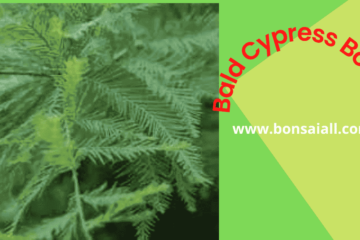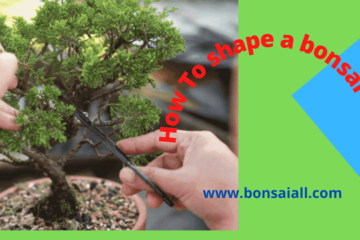The best indoor bonsai tree types will grow in any environment, not just the outdoors. That is why it is very important to know about their care and maintenance. In this article, we’ll provide you with tips on how to water your bonsai tree, fertilize it, trim it, and how to take care of your bonsai tree. We’ll also discuss the different indoor bonsai tree types, and give you a list of the best bonsai trees for the indoors. So stay tuned!
What is indoor bonsai?
Content Overview
Indoor bonsai brings together those evergreen plants that usually live in constant climates throughout the year. These are from tropical climates, primarily, so their minimum temperature range is around 12º C.
It is not recommended to have them outdoors due to the arrival of winter, especially when frost occurs since it can kill them. Of course, they need sunlight, so you will have to place them in an appropriate space where they receive it, even if it is through a window.
The 12 Best Indoor Bonsai Tree Types
There is a good variety of species capable of adapting to the conditions present inside a home, ensuring that they will develop well. Within this group we have:
1. Brussels ficus bonsai tree indoor
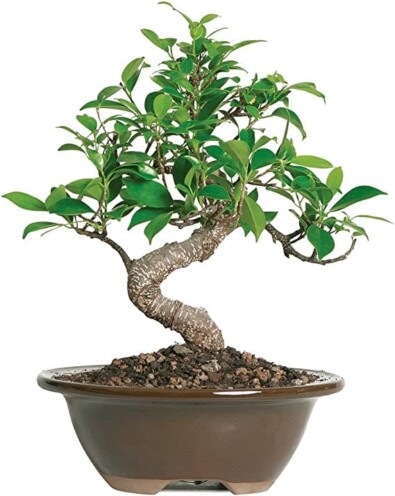
Ficus is the most common indoor bonsai tree for growing inside your home, balcony, Guest room, etc. It is so easy to make, care and Maintainance. Golden Gate Ficus bonsai trees tolerate low humidity and can withstand a lot of poor maintenance. It is the best indoor bonsai tree type for beginners.
In the Ficus family, Golden Gate is the best one for growth indoors. Golden Gate Ficus is the best indoor bonsai tree types for beginners.
Most of the Ficus bonsai trees are fast-growing with a high tolerance for overwater or underwater. Ficus bonsai can thrive in areas with low sunlight and direct sunlight. However, You should make sure it is near the south-facing window. Make sure the tree gets plenty of sun to stay healthy and hydrated. Its required amount of sunlight falls between 10 inches and 14 inches.
On the other side, it’s a reasonable price, it can be a great gift idea for your beloved. It is quite simple to cut into the desired shape. In the end, this is a decent method that could be improved with little effort. Brussels ficus can bring bursts of color to your home. Keep this miniature tree in your home to provide a sense of life and serenity.
Realy, This is a very pretty bonsai tree.
Specifications for a Golden Gate Ficus Bonsai
- Most Favorite Bonsai:
Golden Gate Ficus is a favorite bonsai of most bonsai lovers because of its beautiful structure, beauty, and easy maintenance. So beginner Ficus wants to start with bonsai. This bonsai is perfect for beginners.
- Can be adapted to indoor
The ficus tree is suitable for either indoor or outdoor environments and can grow no matter what environment it’s in.
Does not need a bonsai pocket guide:
Most indoor bonsai trees have to be followed with the help of bonsai care guidelines. Ficus bonsai does not need a little book to tell you how to care for it. To improve the health of this type of plant by following some basic tips. Guides are not required for the care of ficus bonsai. There is no need for a guidelines book to take care of bonsai ficus.
- Indoor air pollution reduce:
The Ficus bonsai can thrive indoors, which is more eco-friendly. This Bonsai not only increase the beauty of your house but also reduces indoor air pollution.
- Valuable Gift for Your beloved:
The vast majority of people love bonsai as a gift. If it is a Brussels ficus bonsai tree, then it will be the best. You can give a ficus bonsai as a gift to anyone you like.
2.GreenBox live Juniper bonsai tree
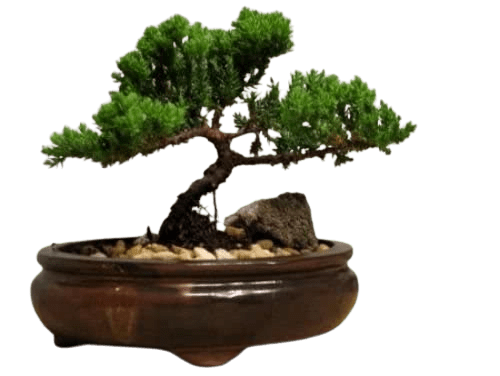
The most popular type of juniper bonsai tree in the market. This can be adapted in any given situation. 9GreenBox live Juniper Bonsai will make a great plant for your indoors.
This variety of juniper conveys the symbolism of strength, harmony, and peace. Raising this type of juniper is an ancient form of plant agriculture that has persisted for decades. I recommend it is the best indoor bonsai tree types for beginners. These sculptures refer to both the art of growing and shaping small-scale items. 9GreenBox is an excellent selection for indoor gardening.
It should be noted that this also includes a 30-day warranty. These are both indoor and outdoor bonsai trees. Whenever you let them stay indoors, it’s a good idea to keep putting them outside at least three days a week.
A GreenBox requires a lot of sun exposure. It’s a good idea to have one, to avoid any and all kinds of diseases. Other benefits include helping to increase your mental and emotional health, as well as improving your patience.
GreenBox live bonsai tree Specification:
- Long live juniper bonsai:
The most amazing thing about these bonsai is that they can live for over 100 years if given proper care and daily maintenance. This results in an elegant appearance for many years.
- Best juniper strong plant:
GreenBox bonsai trees have a higher tolerance to fungus than other indoor bonsai trees. They are resistant to both plant diseases and fungus. This is why this tree can live a long time.
- Ensure good quality:
It will enhance the aesthetic quality of the house. This bonsai will improve quality.
- Great tree to start:
If you are a beginner and have little to no fear of dehydrating your produce, then GreenBox will work for you. People who are just starting to learn how to grow bonsai typically choose the 9GreenBox live bonsai tree.
- Can take advantage of your 30-day warranty:
(Greenbox Bonsai provides a 30-day moneyback guarantee. You can return it within 30-days. However, there are very less bonsai lovers who have taken warranty advantage. - Unique and evergeen bonsai:
A green box Bonsai, which remains evergreen all year round, has a unique look to it. Most people love this.
3. Carmona Fukien Tea Best Indoor Bonsai Tree
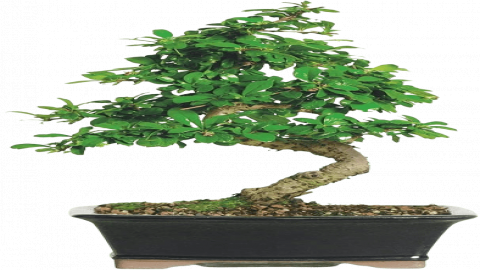
Image Credit: Amazon.com
Carmona Fukien bonsai tree is the best indoor bonsai tree types or shrub that can grow up to 4 meters tall and are very well distinguished by its appearance. In terms of appearance, Carmona in the Fukien bonsai tree is mainly known for carrying a small fragrant white flower that can be displayed by yellow-red berries throughout the year.
But even though they have so many beautiful flowers, they are also famous for their simple appearance. It localizes for ornamental purposes as an indoor bonsai tree in the vicinity of places like Japan, China, Taiwan, Indonesia, and even Australia.
Carmona bonsai can also be identified by their unique leaves that are dark-green and glossy, with a hairy structure at the bottom and small white dots at the top. And their stems are brownish-red in color.
The Fukien Tea Bonsai tree is a very good species to keep indoors because it needs a temperature around 20º C. It is demanding with sunlight, which it expects to receive abundantly on a daily basis. It can be problematic in winter to meet this requirement, so relying on a fluorescent lamp will be the action to take to keep it healthy.
Specification Of Carmona Fukien Tea bonsai
- It requires less maintenance
The Carmona Fukien bonsai Tree grows well when exposed to full sunlight. They need plenty of water in summer and little water in winter and rainy seasons. Always check the soil moisture first. Need to use well-drained and rich soil. The ideal temperature should be above 28º C. and use organic fertilizers, especially in the case of feed from spring to autumn.
- It is a pet-friendly plant:
There are many bonsai trees that are harmful to your cats, dogs, etc. But there is no harm to pets and children if Carmona Fukien grows in your home as a bonsai tree.
- It has many medicinal uses:
Carmona Fukien’s bonsai tree is not just a bonsai tree, it is used as medicine for many diseases. In some places, such as the Philippines, the Carmona bonsai is used as a medicinal plant to treat diarrhea, diarrhea, and even bleeding.
- It is an eco-friendly tree
The Fukien Tea Tree can also be presented as an eco-friendly gift or as a green gift to any enthusiastic green thumb person.
4. Dwarf Jade Best Indoor Bonsai Tree (Crassula)
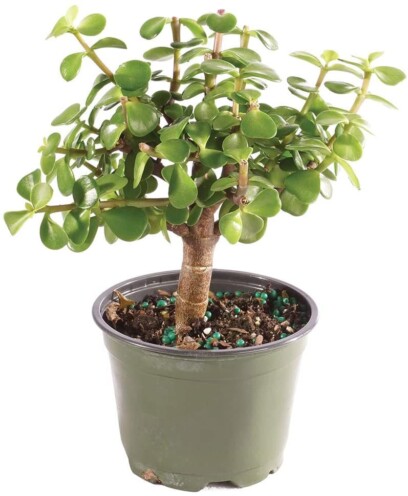
Another most popular Indoor bonsai tree types are Crassula( Dwarf Jade Bonsai Tree). It grows like a small tree with a stem and branches. It is a dry coolant that retains water with tea leaves just like the tea cactus tree.
The dwarf jade bonsai tree is a succulent plant in arid regions of South Africa that explains its ability to store water for a long time.
This succulent is a hardy fellow and has two main requirements for a healthy long life, which are water and plenty of light. They are both indoor and outdoor species, although conditions outside need to be right (enough heat and sun).
This is a very unnecessary bonsai tree. However, the tree is suitable for those who travel most of the time or spend a lot of time outside due to work pressure or those who forget to water the tree most of the time.
It has dense, round, dark green leaves and delicate pink flowers sitting on fleshy stalks and branches. These juicy properties can hold water for a long time.
Although it grows to a height of 10 ‘tall in its local habitat, it is an ideal bonsai for beginners; This beautiful plant is easy to take care of and it will be a beautiful thing for next year.
Specification of Dwarf Jade Bonsai
- Can be adapted indoors:
The ficus tree is suitable for either indoor or outdoor environments and can grow no matter what environment it’s in.
- It is easy to Care:
The dwarf Jade Bonsai plant important factor that the tree three is not required a lot of care. It is perfect for beginners and that person spends minimum time out of home and forgets to give water regularly.
- It holds water Long-time:
It has dense, round, dark green leaves and delicate pink flowers sitting on fleshy stalks and branches. These juicy properties can hold water for a long time.
- It is an eco-friendly tree
The dwarf Jade Tree can also be presented as an eco-friendly gift or as a green gift to any enthusiastic green thumb person.
5. Gardenias Bonsai tree:
When it comes to the decorative indoor bonsai tree, gardenias could give you a true visual gift, since not only can you work on their structure for this purpose,
But they will offer white blooms in their time, what better than that time?
5. The Dwarf or Hawaiian Umbrella
The Dwarf or Hawaiian Umbrella Tree is a tropical tree with compound leaves that is very suitable for indoor bonsai. It can survive dim light and low humidity but it must be protected from temperatures below 10 C / 50 ° F.
6. Sageretia (Chinese Sweet Plum).
The sageretia is also called the Chinese sweet plum or bird plum. It is a subtropical evergreen shrub that can grow 2 – 3 meters (7 to 10ft) high and is native to China and Japan. It is a popular indoor Bonsai.
7. Privet (Ligustrum Bonsai Tree)
Although it is not recommended that bonsai be moved from the place where they are established, an exception could be made with the privet. It is a species that loves high temperatures and direct sunlight but is not resistant to the arrival of winter. For this reason, it is possible to keep it outside during the warm season and then move it inside to weather the cold weather.
8. Cuphea tree
The Cuphea is an evergreen shrub of tropical and subtropical origin. This means that it cannot withstand the heat, cold, or persistent snowfall.
He lives very well inside the house because the temperatures are stable. Remember to Place it next to a large window so that it gets enough sunlight to grow
9. Chinese Elm Bonsai
The Chinese Elm is indigenous to China and south-east Asia. In its native environment, it can be a mighty tree reaching heights of up to 80 feet (25 meters). It develops a fine branch ramification with small leaves, which makes it a very suitable Bonsai plant.
10.MurrayTree
A medium to large shrub, Murraya generally grows 3–4m but given ideal conditions, and if left unpruned, it can reach 8m or more. Murraya is most often seen trimmed into hedges. Its small deep green leaves form a dense canopy, giving it a very lush, tropical look.
11. Schefflera Bonsai
Like the ficus, Schefflera plants prefer low light and low humidity, and they do best when you want a plant that you may shape and train.
12.Serissa Japonica (Snow Rose) Bonsai
The Serissa Japonica bonsai is recognized for its beautiful tiny white blooms, which bloom in the spring and summer. But that’s not all (really, we could go on forever).
We’ve added this one last since it’s not as simple to care for as our previous five options, which are known as “the tree of a thousand stars.”
Temperature fluctuations, as well as light and water levels, can influence how it responds. Depending on the climate where you live, it may grow both indoors and outdoors.
WHAT ARE THE CARE FOR INDOOR BONSAI TREE?
Before going into detail about indoor bonsai care, let’s pause. It is true that they are not as complicated trees as it is painted. But that does not mean that we lose sight of reality: they are delicate trees.
We are talking about a plant species that is incredibly receptive, for better or worse, to any change that occurs around it. That is why we have to be careful with changes in light, currents, and even irrigation.
The slightest modification in your space can affect the well-being of our plant. Hence the popular image that bonsai demands time and dedication. A belief that, in this case, is completely true.
That said, let’s see what are those bonsai care that will allow us to grow it without too much complication at home.
And no, we are not going to go into more advanced details such as how to prune a bonsai. Let’s start at the beginning that there will be time to get to that point!
Where to place the Indoor bonsai tree?
The location of a bonsai differs depending on whether it is an indoor or outdoor species.
Indoor bonsai have the following characteristics:
- They need lots of light, heat, and humidity.
- They are sensitive to drafts.
- Their growth is slightly slowed down in winter.
In summer, despite their name, indoor bonsai can be placed outside. Growth will be more vigorous and they will be more resistant to pests and diseases.
If you don’t have a garden, you can place your bonsai on a balcony or window sill.
Most indoor bonsai species cannot tolerate frost. During the winter season, place them protected from frost in a cold greenhouse, or an unheated veranda, or, failing that, near a window in a cool room.
In any case, the location must be sunny, bright, and with a humid atmosphere.
Avoid certain locations:
- Places that are too dark, such as a cellar or an attic without windows.
- Above a running radiator, because the air there is much too dry.
- Near a door or window that is often open because of drafts.
Exposure to sunlight
They need it and there is no way to fully replace it because it is key for them to carry out photosynthesis and thus develop.
The best strategy to offer it is placing the bonsai in a window where the rays penetrate without blockages. That is, it must be free of curtains.
Specialists recommend that this window be oriented with a view to the south because it represents the best incidence space for the sun’s rays.
When a bonsai doesn’t get enough sunlight it will start to weaken and you need to be vigilant to apply a quick change.
Otherwise, and even if it doesn’t happen immediately, it will end up dying.
In any case, a strategy that can probably be useful at certain times is to take advantage of extra fluorescent light.
Environmental humidity is key to your well-being
Again: they are trees and, added, of tropical origin. In no case are they accustomed to a dry environment? Hence, if we want to see them prosper correctly, we have to create a microclimate for them.
It is not as complicated as it seems. Simply place a fountain or pot larger than the bonsai under it with water.
Then it will be enough to place a layer of volcanic clay and, on top of it, the bonsai. In this way, it will be able to have the moisture it needs without its roots being able to rot.
But it is not the only practice that we will have to carry out as part of the bonsai care. It also does not hurt to regularly clean its leaves to promote photosynthesis and, once clean, spray water. A simple way to keep your leaves hydrated.
Hydrate
Don’t water just because it’s convenient. Make sure your tree’s soil doesn’t get too dry by monitoring it. This might happen every day or for multiple weeks for some trees, depending on the species.
To avoid over-watering, use a moisture meter. Let the water soak all the roots in your pot until it runs out of the drainage holes when it’s time to give your tree a drink.
Ventilation
Airflow is essential for bonsai to be healthy and not develop diseases.
Considering that the humidity of the space must be more or less high, ventilation becomes even more important because it depends on it that fungi do not occur.
It is even recommended that you leave a window open for a few hours in the place where the bonsai is.
The temperature is better warm than cold
As we said at the beginning, we are dealing with tropical or subtropical trees. Some origins give us a clue about their heat needs.
The ideal for this type of bonsai is the temperature that we can have on a regular basis in the living room of our house. In the case of subtropics and depending on the species, it is possible to grow them at a somewhat lower temperature But let’s not tempt fate!
Beyond the degrees of the comfort of these bonsai, which are the same as ours, one moment. Nothing to a place near artificial sources of heat or cold. Bonsai demands a stable and constant temperature.
Pro Tips:
Ambient temperature plays a major role, especially from fall to spring. During this period, bonsai of tropical origin require temperatures between 11° C and 19° C at night, and 20° C to 26° C during the day.
The subtropical indoor bonsai will prefer cooler temperatures, 5° C to 10° C at night and 11° C to 17° C during the day.
Irrigation, another fundamental indoor bonsai tree care
Another of the fundamental bonsai care that we have to monitor closely. And it is that, for more indications that appear in the pot of our bonsai, the irrigation pattern is as unique as each plant.
The reason is simple. It not only depends on the hours of light it receives or its intensity. It also does so from many other factors such as the species of the tree, its size, or even the time of year.
For this reason, the ideal is to rely on the humidity of the substrate. One that can never get dry as it could bring us serious problems.
Avoiding it happens by observing it and watering again once we see that the surface has begun to dry. The bonsai, like a good tree, needs humidity.
But be careful: let’s not confuse this with that typical gesture of leaving water in the low saucer of the pot. Far from being positive, it can rot your roots.
Using a specific watering can for bonsai allows us to water as the plant needs. Get this model in our online store
With regard to watering, let’s also see some particularities. To begin with, it is advisable to water in two stages.
A more superficial initial one, which slightly wets the substrate. After a few minutes, the ideal is to water more deeply until you see how the excess is evacuated through the holes in the pot.
Only in this way can we guarantee that the water conveniently penetrates the roots, and wets them as needed.
In addition to this, it is advisable to use a specific shower. What is this? Well, one that its pineapple is perforated with a good number of small holes.
They not only simulate rainwater. In addition, they allow being respectful with the substrate for bonsai. The idea is to alter it as little as possible.
Spray foliage and soil for Indoor Bonsai Tree
In principle, the excess water from the watering is sufficient to moisten the tray. To accentuate the humid atmosphere, each day spray the foliage, and the surroundings, with rainwater at room temperature.
The soil should never dry out between two waterings, but should not be soggy. The smaller the container, the less soil there is, and therefore less water reserve, the closer the watering should be. Test with your finger: it’s the safest way.
Indoor Bonsai Fertilization
Bonsais are trees grown in a small volume of soil and the only nutrients present in them are not enough. They need to receive fertilizer in order to enrich the soil with nutrients.
It is necessary to fertilize the bonsai throughout the growing season of the tree with a fertilizer preferably organic with balanced NPK, for example, Biogold.
The role of the elements of fertilizer for bonsai
- Nitrogen (N): Promotes and stimulates foliage growth.
- Phosphorus (P): Improves root growth and disease resistance.
- Potassium (K): Promotes flower and fruit development in bonsai.
Tips and Tricks:
- Fertilize sparingly but regularly.
- Prefer the use of organic fertilizer with slow decomposition to liquid fertilizer (Ex. Biogold ).
- Do not fertilize a weak tree or just after repotting.
- If you use a liquid fertilizer, halve the doses indicated by the manufacturer. And don’t fertilize on dry land.
Read More : The Ultimate Guide To Best Bonsai Tree Fertilizers
Bonsai repotting
Over time, the bonsai grows and the roots take up more and more space in the pot until they fill the entire space. So that the tree does not end up cramped, regular repotting is necessary and eliminates roots that are too long.
At the same time, the soil is depleted of nutrients that are necessary for bonsai. Repotting gives the opportunity to renew the depleted substrate by providing it with new nutrients so that it can continue its development and create new shoots.
In general, repotting is done every 2 to 3 years in the spring depending on the species and the age of the bonsai.
In short: Repotting the bonsai does not consist of putting it in a larger pot, but rather of pruning the roots and renewing the substrate.
Read More: How to Repot a Bonsai for Beginners Complete Solutions
The substrate
Each species requires its own soil composition. But in general, the substrate must be draining, aerated and rich in nutrients while having good water retention.
Bonsais generally grow well in gritty mixtures of Akadama and Pozzolan. This granulated substrate facilitates the circulation of air in the pot and the flow of irrigation water while retaining enough humidity to meet the needs of the tree.
However, some species such as Azalea (rhododendron) and some conifers require an acidic substrate, so it is best to use a mixture of Kiryu and Kanuma.
Bonsai pruning
Pruning is a fundamental operation in the art of bonsai. It is she who makes it possible to create or maintain the shape and style of the tree.
There are two different types of pruning: structural pruning and maintenance pruning.
structure size
As its name suggests, the structure pruning allows you to give or restore a style to your bonsai. It mainly consists of taking care of the large branches and the trunk of the tree.
Structural pruning is usually done at the end of the vegetative period because some branches have grown too much or in directions that deform the bonsai. When pruning large branches, do not hesitate to apply a healing putty.
maintenance pruning
Maintenance pruning or green pruning is practiced throughout the tree’s growth period and improves branching and maintains or refines an existing shape.
It consists of cutting:
- Branches that grow inward and interfere with light penetration
- The branches that distort the style of bonsai
- The dead branches
Ligation
Wiring is a technique used for the creation, maintenance, and shaping of a bonsai. It makes it possible to correct the inclination or to modify the orientation of certain branches.
The technique involves wrapping copper or aluminum wire ( binding wire ) around the branches or trunk in order to bend and position the branches in the desired direction. When the wires are removed after several months, the branches will keep their new shapes.
Ligation can be practiced all year round for most species. However, special attention must be paid during the growth period.
The branches grow rapidly and the ligature wire can become embedded in the bark which can then leave deep scars which can be unsightly.
Propagation Steps Indoor Bonsai Tree
Fresh cuttings are all you need to grow a bonsai tree. It’s one of the most enjoyable aspects of bonsai tree care, and it’s also the simplest and most prevalent technique to get another tree growing.
In the warmer months, you must propagate, either in spring or summer.
You’ll need some cuttings from your bonsai tree to get started. When you’re trimming and pruning your tree next time, you can do this. For bonsai tree care, it is critical to groom your tree.
The cutting should be four to six inches long when you go to cut it. There should be three leaves or at least three nodes. The bigger the better. Scissors should not be used. Clippers should always be used.
Trim off the bottom leaf or leaves until you get to the point where you trimmed. Next, at a 45-degree angle, slice the bottom. For the best results, use a twig shear. This makes it simpler to put the cuttings in potting soil.
Now it’s time to gather your pots and pans. At the bottom of the pot, lay your bonsai tree soil mix.
Make sure the cuttings are at least an inch deep in the soil. Make sure it’s upright before putting it up. Try tying a straw to the cutting and putting it in the soil beside it if it won’t stand up on its own.
To retain moisture, place cuttings in a plastic bag. The odds of the cuttings developing into a new bonsai tree will be improved.
It’s time to put the cuttings in a dark area and let them root. When the soil is almost dry, you have to water them, just as you would if they were grown.
After approximately a month, your bonsai tree cuttings should be rooted. Gently pull up on the cutting to double-check. It’s rooted if it doesn’t want to surface.
Remove the plastic cover after your cuttings are rooted. It’s created the humidity that it was designed to do. If it’s left on for a long period, mold and mildew may develop. Your new bonsai tree requires fresh air right now.” Your tree or trees will grow in three to five weeks, depending on the variety.
Indoor Bonsai Tree Care in Winter
Winter is a critical time for an indoor bonsai tree. With the heating and the days getting shorter, the bonsai can suffer from the dryness of the air and the lack of light.
If the bonsai is not a tropical species and must enter a period of dormancy, it is preferable to place the bonsai in a less heated room than the living room, but still bright. The ideal location would be a cold greenhouse or an unheated corridor so that it is protected from frosts, heavy rains, and strong winds.
If a sufficiently bright place is not possible, there are horticultural lamps available on the market in garden centers or online which can improve the brightness of the bonsai.
Watering should be regular and carefully monitored. To cope with the dryness of the air, vaporizing the bonsai will help maintain a good level of humidity.
In winter, fertilization and fertilizer are stopped for most species except for tropical bonsais which continue to grow, even though this is slowed down by the lack of light.
In case of window opening or ventilation, be careful of the draft and the sudden difference in temperature which can cause the loss of the leaves of the bonsai. This is even truer for species like the ficus .
Indoor Bonsai tree care in Summer
Like the outdoor bonsai, the bonsai must be watered regularly while allowing the soil to dry out between two waterings.
For some indoor species, it is possible to continue fertilizing without exceeding two fertilizer inputs per month.
Regarding location, indoor bonsai tree can be placed outdoors for more vigorous growth.
In summer and indoors, the conditions are conducive to the appearance of pests or diseases. It is therefore imperative to regularly monitor the bonsai and apply treatment if necessary.
Clamp your Indoor Bonsai Tree
Pinching is essential to maintain the shape of the bonsai. It is very simple, cut the longitudinal growths of the year that break the foliage profile of the tree canopy and use very sharp scissors.
Try to do it whenever you can because it is very important, it affects the outer parts of the branches and the upper part of the tree.
With this action, you will promote the tree to distribute its strength by growing more evenly and you will notice that the foliage is much denser.
Depending on the species and the vigor of the bonsai you have, you should pinch more or less frequently, observation here is essential.
Thank you for reading our blog! In this post, we discussed the different types of indoor bonsai tree care and discussed the necessary steps for taking care of them. We also provided a CTA to our website, which includes detailed instructions on how to water, fertilize, light, prune, and shape your bonsai plants. By following these instructions carefully, you will be able to successfully take care of your bonsai plants indoors!

